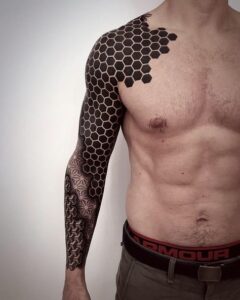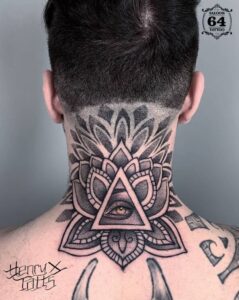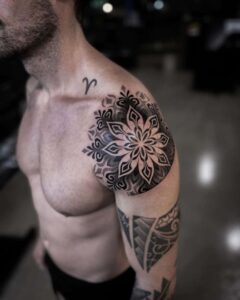Geometry Tattoos: Exploring the Art, History, and Impact #Geometry tattoos
Geometry tattoos have surged in popularity, blending artistic expression with mathematical precision. These tattoos, characterized by shapes like triangles, circles, and polygons, offer both aesthetic appeal and deep symbolism. In this blog, we will explore the history, positive aspects, and potential drawbacks of geometry tattoos.

History of Geometry Tattoos #Geometry tattoos
Geometry Tattoos trace their roots back to ancient civilizations. The Greeks and Egyptians, for instance, used geometric patterns in their art and architecture, symbolizing balance and harmony. Sacred geometry, involving patterns like the Flower of Life and Metatron’s Cube, has spiritual significance in various cultures, representing the building blocks of the universe. The resurgence of geometry tattoos in modern times reflects a fascination with these ancient concepts, blending historical significance with contemporary design.
In ancient Greece, geometric patterns were often used in pottery, mosaics, and architecture. These patterns were not only aesthetically pleasing but also imbued with meaning. The Greeks believed that geometry was the language of the gods, and using these patterns in their art was a way to connect with the divine. Similarly, in ancient Egypt, geometric patterns were prevalent in their art and architecture. The Egyptians used geometric shapes in their hieroglyphics and tomb decorations, believing that these shapes held magical properties that could protect the deceased in the afterlife.

The concept of sacred geometry has roots in many ancient cultures. The Flower of Life, for example, is a pattern of overlapping circles that has been found in temples and manuscripts across the world, from Egypt to China. This pattern is believed to represent the cycle of creation and is considered a symbol of the interconnectedness of all life. Metatron’s Cube, another popular design in geometry tattoos, is a complex geometric figure that includes all the Platonic solids. It is named after the archangel Metatron and is thought to be a map of the creation of the universe.

Positive Aspects of Geometry Tattoos
- Aesthetic Appeal: Geometry tattoos are visually striking. Their clean lines and precise shapes create a sophisticated and elegant look that appeals to many.
- Symbolic Meaning: Many people choose geometry tattoos for their symbolic meanings. Shapes like circles represent eternity and unity, while triangles can symbolize strength and stability.
- Versatility: Geometry tattoos can be customized to suit individual preferences, making them versatile. They can be minimalistic or intricate, black and grey or colorful.
- Timelessness: Unlike some tattoo trends that fade over time, geometry tattoos tend to remain timeless due to their classic design elements.
- Cultural Significance: For those interested in sacred geometry, these tattoos can be a way to connect with ancient wisdom and spiritual practices.

- Personal Expression: Geometry tattoos allow individuals to express their personal beliefs and interests. Whether it’s a love for mathematics, a connection to nature, or spiritual beliefs, these tattoos can be a deeply personal statement.
- Creativity: The precise nature of geometry tattoos often requires creative thinking from both the tattoo artist and the client, leading to unique and personalized designs.
- Balance and Harmony: Geometric designs often symbolize balance and harmony, which can be a meaningful reminder for the wearer.
- Connection to Nature: Many geometric patterns are found in nature, such as the hexagons in a honeycomb or the spirals in a nautilus shell. Geometry tattoos can be a way to celebrate the natural world’s beauty and complexity.
- Meditative Quality: The process of designing and receiving a geometry tattoo can be meditative. The repetition and symmetry in the patterns can promote a sense of calm and focus.
Potential Drawbacks of Geometry Tattoos
- Complexity in Design: The precision required for geometry tattoos means they need a highly skilled tattoo artist. Any slight mistake can be noticeable.
- Healing Process: Due to the detailed lines, geometry tattoos can have a more challenging healing process. Proper aftercare is essential to maintain their sharp appearance.
- Trendy Nature: While geometry tattoos are currently popular, trends can change. What is fashionable today might not be in a decade, though the timelessness of geometric shapes can mitigate this risk.

- Personal Connection: As with any tattoo, it’s crucial for the individual to have a personal connection to the design. Choosing a geometry tattoo purely for its aesthetic without personal significance might lead to regret.
- Maintenance: Keeping the lines of a geometry tattoo crisp and clear may require touch-ups over time, especially if the tattoo is exposed to the sun frequently.
- Pain Factor: Depending on the placement and complexity, geometry tattoos can be more painful than simpler designs, requiring longer sessions under the needle.
- Cost: Due to the complexity and the time required, geometry tattoos can be more expensive than simpler designs. It’s important to consider the financial investment.
- Potential for Distortion: Over time, as the skin changes, there’s a risk that the precise lines of geometry tattoos might blur or distort.
- Limited Artist Availability: Finding a tattoo artist skilled in geometry tattoos can be challenging. It’s essential to research and choose an artist with a strong portfolio in geometric designs.

- Time-Consuming: The intricate nature of geometry tattoos often means longer tattoo sessions. This can be demanding for both the artist and the person getting the tattoo.
Choosing the Right Artist for Geometry Tattoos
Selecting the right artist is crucial when it comes to geometry tattoos. Look for someone who specializes in geometric designs and has a portfolio that demonstrates their skill and precision. Consult with them about your ideas and ensure they understand the significance and details you want in your tattoo. The right artist can bring your vision to life with the accuracy and artistry that geometry tattoos demand.

When researching potential tattoo artists, consider the following tips:
- Check Portfolios: Review the artist’s previous work, focusing on their geometric designs. Look for clean lines, symmetry, and overall quality.
- Read Reviews: Look for reviews from previous clients. Positive feedback regarding the artist’s professionalism, skill, and cleanliness is essential.
- Consultations: Schedule consultations with a few artists. Discuss your ideas and see how they interpret your vision. A good artist will offer suggestions and make sure they understand your preferences.
- Ask About Experience: Inquire about the artist’s experience with geometry tattoos specifically. The more experienced they are, the better the result is likely to be.
- Observe Hygiene Practices: Ensure the tattoo studio follows strict hygiene practices. Cleanliness is vital to prevent infections and ensure a smooth healing process.

Popular Geometric Tattoo Designs #Geometry tattoos
- Mandala Tattoos: These are intricate designs often featuring circles and other geometric shapes arranged in a symmetrical pattern. They are highly detailed and often hold spiritual significance.
- Sacred Geometry: Designs like the Flower of Life, Metatron’s Cube, and other sacred geometry patterns are popular for their spiritual meanings and intricate details.
- Animal and Nature Integration: Combining geometric shapes with animals or nature elements like trees and flowers creates a stunning contrast between the natural and the precise.

- Minimalistic Geometric Shapes: Simple triangles, circles, squares, and lines can make a bold statement with their minimalistic yet powerful designs.
- 3D Geometric Tattoos: These tattoos create the illusion of depth and dimension, making the geometric shapes appear as if they are popping off the skin.
- Geometric Sleeve Tattoos: A full or half sleeve of geometric patterns can be a striking and cohesive piece of body art.
- Polygonal Animal Tattoos: Animals depicted in geometric forms, using polygons and lines, blend natural imagery with modern design.
- Geometric Landscape Tattoos: Combining natural landscapes with geometric patterns creates a beautiful and unique tattoo design.
- Fractal Patterns: These intricate, repeating patterns are visually captivating and make for stunning tattoos.

- Geometric Tribal Tattoos: Modern interpretations of traditional tribal tattoos often incorporate geometric patterns for a contemporary twist.
Aftercare Tips for Geometry Tattoos
- Follow Artist’s Instructions: Always adhere to the aftercare instructions provided by your tattoo artist to ensure proper healing.

- Keep It Clean: Gently wash the tattoo with mild soap and water to prevent infection.
- Moisturize: Apply a recommended tattoo aftercare lotion to keep the skin hydrated.

- Avoid Sun Exposure: Protect your tattoo from direct sunlight to prevent fading and distortion.
- Avoid Submersion in Water: For the first few weeks, avoid swimming or soaking the tattoo in water.
- Wear Loose Clothing: Ensure that your clothing does not rub against the tattoo, which can cause irritation.
- Avoid Picking: Do not pick or scratch at scabs or peeling skin, as this can affect the final appearance of the tattoo.
- Stay Hydrated: Drinking plenty of water helps keep your skin healthy and aids in the healing process.

- Avoid Heavy Exercise: Avoid strenuous activities that may cause excessive sweating or stretching of the tattooed area during the initial healing phase.

- Check for Allergic Reactions: If you notice any unusual redness, swelling, or irritation, contact your tattoo artist or a healthcare professional. Incorporating geometry tattoos into your personal style can be a deeply rewarding experience. With their rich history, significant meaning, and striking
